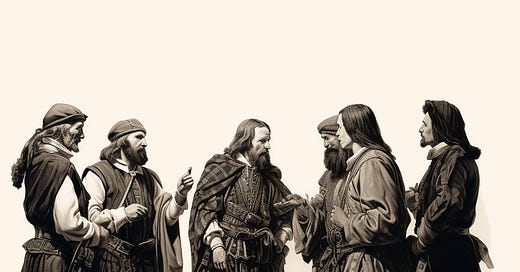Scotland's medieval period was marked by fierce loyalties, ambitious power plays, and the rise and fall of noble houses. Among these, the story of the Black and Red Douglas families stands out as a particularly captivating tale of rivalry, power, and political maneuvering.
The Emergence of the Douglas Dynasty
The Douglas family, of Flemish origin, had been a significant force in Scotland since the 12th century. It was William the Hardy, father of the 'Good Sir James', who laid the foundation of the Douglas dynasty. Sir James Douglas, a loyal companion of Robert the Bruce, became a Scottish hero, his exploits in the Wars of Independence part of Scottish legend.
The Black Douglas: A Symbol of Defiance
The Black Douglas line, descended from the 'Good Sir James', is perhaps most famously embodied in Archibald 'the Grim', a formidable warrior of the 14th century. His strength and military prowess were such that, according to chroniclers like Froissart, he was a figure of awe on the battlefield. The Black Douglases became a symbol of Scottish resistance against English incursion, holding immense power and vast lands, from the Borders to the Highlands.
The Red Douglas: Rising from the Ashes
In contrast, the Red Douglas line originated from a different branch of the family. This line came into prominence with George Douglas, the first Earl of Angus, born from the union of a Douglas and a Stuart. The Red Douglases, though equally powerful, were known more for their political acumen than their battlefield exploits. They often found themselves in opposition to the Black Douglases, especially during times of political upheaval.
A Struggle for Dominance
The rivalry between the Black and Red Douglases was not just a family feud but a reflection of the broader political struggles in Scotland. The Black Douglases, often at odds with the monarchy, saw their power reach its zenith under James 'the Gross'. But their refusal to bend to royal authority led to their downfall. In a dramatic turn of events, King James II assassinated William Douglas, 8th Earl of Douglas, in 1452, leading to the eventual downfall of the Black Douglas line.
The Ascendancy of the Red Douglases
With the fall of the Black Douglases, the Red Douglases rose to prominence. Their ability to navigate the complex political landscape of the time allowed them to gain favor with the monarchy. The marriage alliances, notably between Archibald Douglas, the 6th Earl of Angus, and Margaret Tudor, further strengthened their position, intertwining their fate with that of the Scottish crown.
Legacy and Historical Significance
The tale of the Black and Red Douglases is more than a story of a family feud; it is a narrative that encapsulates the essence of feudal Scotland. Their rivalry mirrored the larger power dynamics at play – a struggle between the emerging centralized authority of the monarchy and the traditional powers of the feudal lords. This power struggle played a significant role in shaping the political landscape of Scotland, leading up to the pivotal moments like the Scottish Reformation and the Union of the Crowns.
The saga of the Black and Red Douglas houses provides a captivating glimpse into the turbulent and dynamic period of Scottish history. Their story, marked by bravery, betrayal, and political intrigue, remains a significant chapter in the annals of Scotland's feudal past.





